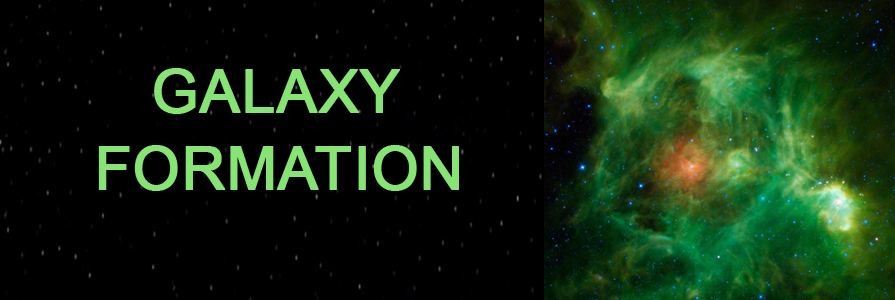
Recombination And Reionization
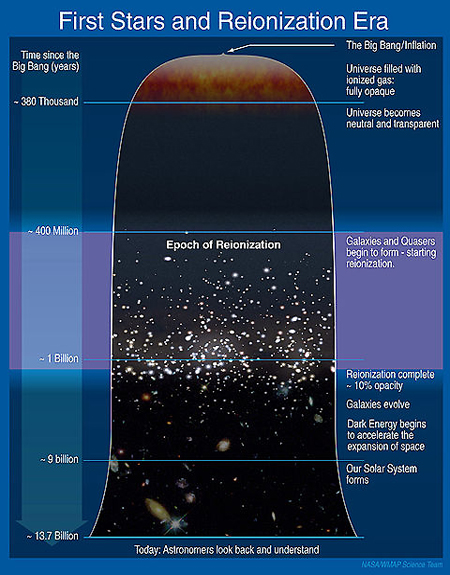
Immediately after the Big Bang, the universe was a hot, dense plasma of electrons, protons and photons. This plasma was opaque to electromagnetic radiation (light), as the distance each photon could travel before scattering off another charged particle was extremely short. As the universe expanded, it also cooled. Eventually, the universe cooled to the point that neutral hydrogen formed (one electron and one proton joined together). The ratio of of free electrons and protons compared to neutral hydrogen atoms decreased to about 1 in 10,000. This era of the "phase change" of random electrons and protons into neutral hydrogen atoms is called the "Recombination Era". This occurred about 380 "thousand" years after the Big Bang.
As a by product of the formation of hydrogen, electromagnetic radiation (light) could now freely travel so that the universe became transparent. Once the photons (electromagnetic radiation) became decoupled from the hydrogen, they traveled all around the universe and are still traveling today. They are now called the Cosmic Microwave Background (CMB) because as the universe expanded so did the tiny "gamma" waves. Thus, we can never "see" anything earlier than 380,000 years. The state of the universe as it was 380,000 years after the Big Bang is sometimes referred to as the last "scattering surface".
The second phase change, occurred once objects started to form in the early universe. As these objects (stars and galaxies) formed and radiated energy, the universe went from being neutral back to being an ionized plasma. This second phase change era is called "Reionization". Recent data has lead astro-physicists to estimate that reionization started as early as 200 "million" years after the Big Bang (as opposed to 400 million in the NASA chart to the left). It lasted about 750 million years until the universe was about 950 million years old.

The early universe was very violent during reionization. Galaxies grew quickly and evolved into monsters swallowing up nearby smaller galaxies. The first stars were probably hundreds of times more massive than the sun and millions of times as bright. They most likely burned for just a few million years before exploding as supernovas. It is believed that the strong ultraviolet radiation from these early stars split hydrogen atoms back into electrons and protons, thus ionizing them a second time.
The diagram to the left correlates a redshift reading to the age of the universe. For example a redshift of 6 correlates to the universe being about 950 million years old (after the Big Bang). A redshift of 11 (the most ever recorded) indicates an age of 420 million years. The bottom scale (redshift number) is linear, while the top scale (age) is non-linear. Top
Galaxy Formation
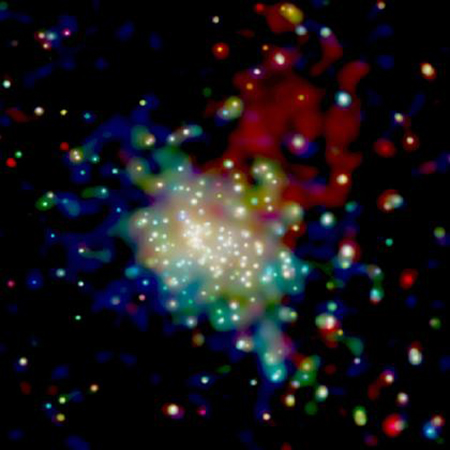
The Nebula Model builds galaxies by the merging of interstellar cold, dense gas clouds. These globules started collapsing into galaxies when the universe was very young. Then the early galaxies would be drawn into clusters and clusters into super clusters by their mutual gravity. This model predicts that there should be many more small galaxies than large galaxies and this is observed to be true.
Galaxy clusters and super clusters should still be in the process of forming today. Observations suggest this is also true. See the X-ray image to the left of the young star cluster RCW 38. All the white dots are hot young stars forming a new galaxy cluster. NASA's Chandra has detected about 200 new stars being born in RCW 38.
Recent versions of the Nebula Model incorporate dark matter that is known to make up most of the mass of the universe. Huge dark matter super clusters come together because of gravity and form a network of filaments. Where dark matter filaments intersect and form dense regions, regular matter coagulates into galaxies and galaxy clusters.
One version of the model says that the very densest dark matter regions have more rapid star formation and make elliptical galaxies while the lower density concentrations make spiral galaxies and dwarf galaxies. Visible matter is at the very densest part of large dark matter clouds which are out of sight.
Some dark matter clumps may contain only cold hydrogen and helium gases making "dark nebulae" that are not concentrated enough to begin star formation.

Dark Matter Evidence. The two false-color Hubble maps at the left compare the distribution of normal matter (red) with dark matter (blue) in the exact same area of the universe. The brightness of the clumps corresponds to the density of their mass. It demonstrates how normal matter (stars, galaxies and gas) is concentrated inside a surrounding cloud of dark matter, and how the densest dark matter areas condense into normal matter. Because dark matter can't be seen directly, its distribution was determined by using gravitational lensing techniques (see the "Searching For The Oldest Galaxies" section below).
The above images were constructed from Hubble's largest ever survey of the universe, the Cosmic Evolution Survey (COSMOS). In making the COSMOS survey, Hubble photographed 575 adjacent and slightly overlapping views of the universe using the Wide Field Camera. It took about 1,000 hours of observations. The distribution of additional gas outside of the galaxies was achieved using ESA's XMM/Newton telescope. All this was accomplished with an international team of 70 astronomers from NASA, ESA, and R. Massey of the California Institute of Technology.
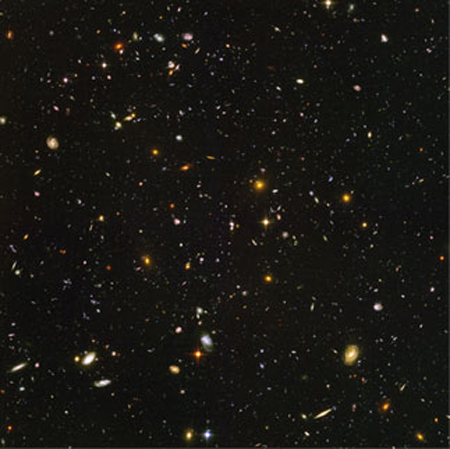
Other Models. Astronomers from Cardiff University in Wales, UK observed about 10,000 galaxies currently present in the universe using a survey of the sky created by the Herschel ATLAS and GAMA projects. The researchers classified the galaxies into the two main types: flat, rotating, disc-shaped galaxies (much like our own galaxy, the Milky Way); and large, oval-shaped galaxies with a swarm of disordered stars. Using the Hubble and Herschel telescopes, the researchers then looked further out into the universe (thus further back in time) to observe galaxies that formed shortly after the Big Bang. See the Hubble Deep Field View of 1,000 such galaxies to the left.
The researchers showed that 83% of all the stars formed since the Big Bang were initially located in a disc-shaped galaxy. However, only 49% of stars that exist in the universe today are located in disc-shaped galaxies. The 51% remainder are located in oval-shaped galaxies. The results suggest a massive transformation in which disc-shaped galaxies became oval-shaped galaxies.
One popular theory is that this transformation was caused by many cosmic crashes, in which two disk-dominated galaxies, straying too close to each other, were forced by gravity to merge into a single galaxy. The merger would have destroyed the disks and produced a huge pileup of stars. An opposing theory is that the transformation was a more gentle process, with stars initially formed in a disk gradually moving to the center of the disk (forced by gravity).
All Galaxies Rotate. Astronomers have discovered that all galaxies make a complete rotation about once every billion years no matter how big they are. "It's not Swiss watch precision," said Professor Gerhardt Meurer from the International Centre for Radio Astronomy Research (ICRAR). "But regardless of whether a galaxy is very big or very small, if you could sit on the extreme edge of its disk as it spins, it would take you about a billion years to go all the way around." Top
Galaxy Classification

Galaxies come in a very wide range of sizes and shapes. Edwin Hubble, who studied galaxies for years, came up with a classification scheme (shown on the left) to categorize the galaxies basic characteristics. Because of its shape it is often referred to as "Hubble's Tuning Fork". To this day, the Hubble sequence is the most commonly used system for classifying galaxies in astronomical research. One of the drawbacks of the Hubble scheme is that it depends purely on visible light.
Hubble classified galaxies into 4 broad categories: ellipticals, spirals, lenticulars, and irregulars.
Ellipticals - Elliptical galaxies have smooth, featureless light distributions and appear as ellipses in photographic images. They are denoted by the letter E. The ellipticity increases from left to right on the Hubble diagram, with circular (E0) galaxies situated on the very left.
Spirals - A spiral galaxy consists of a flattened disk with stars forming a spiral structure and a central concentration of stars called the "bulge". Roughly half of all spirals are also observed to have a bar-like structure extending from the central bulge, at the ends of which the spiral arms begin. In the Hubble diagram above, the regular spirals (reddish color) occupy the upper branch and are denoted by the letter S, while the lower branch (yellowish) contains the barred spirals given the symbol SB (capital B). See some samples of the various galaxy types below.
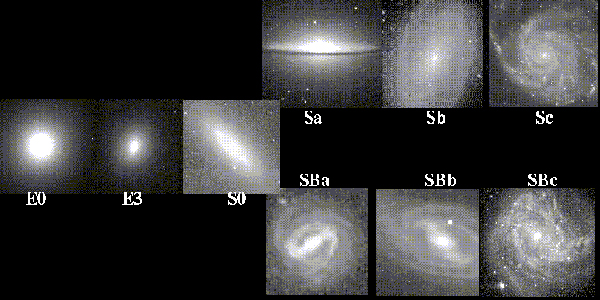
Lenticulars - At the center of the Hubble diagram where the spiral arms meet is an intermediate class of galaxies known as lenticulars represented by the symbol S0. These galaxies consist of a bright central bulge surrounded by an extended disk-like structure. The disks of lenticular galaxies have no spiral structure and are not actively forming stars in any significant quantity. The bulge component is the dominant source of light.
Irregulars - Galaxies that do not fit into the Hubble scheme because they have no regular structure (either disk-like or ellipsoidal), are called irregular galaxies. Irregular galaxies have asymmetric profiles and lack a central bulge or a spiral structure. Instead, irregulars contain many random individual clumps of young stars that are not resolved into stellar clusters. Top
Searching For The Oldest Galaxies

The three-way alignment of an original distant blue galaxy, a galaxy lens cluster and the earth, vastly amplifies the light reaching us from the blue galaxy allowing astronomers to make detailed observations not otherwise possible. See the illustration above.
Using galaxy Abell 383 as a gravitational lens, astro-physicists were able to observe "one" of the oldest galaxies in the universe. Abell 383, with its very strong gravity field, bends the rays of ancient light like a huge magnifying glass. See the actual Hubble image at the left below. The ancient galaxy is visible as two tiny dots on either side of Abell 383. (Distant objects seen through gravitational lenses are typically multiple imaged and heavily distorted.) Without the gravitational lens, the galaxy would have been too faint to be observed even with today’s largest telescopes.
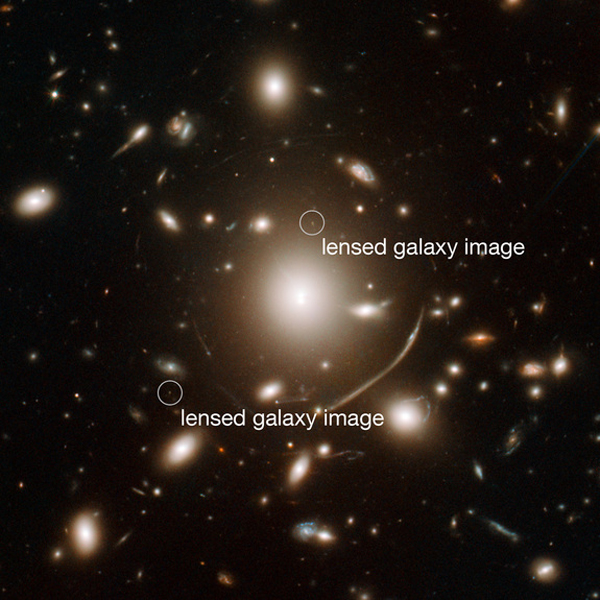
The galaxy is made up of very faint stars about 750 million years old, making the galaxy's formation about 200 million years after the Big Bang. That makes the galaxy's formation about 200 million years earlier than the oldest previously known galaxy. This is younger than expected as the previous estimates for the start of reionization were about 400 million years after the Big Bang. This finding could force astronomers to rethink the timing and the formation of stars and galaxies in the early Cosmos.
Using the Keck-2 telescope in Hawaii, the team then analyzed the galaxy's light, determining its redshift. Redshift measures the distance that an object has moved away from earth as space expands by observating the stretching of the object's light to longer (redder) wavelengths. The remote galaxy’s redshift is 6.027, which means we see it as it was when the universe was about 950 million years old. This does not make it the furthest galaxy ever detected One has been detected with a redshift of 10.7 which makes it about 420 million years old. See the next section.
Today we can only discover these ancient galaxies by observing them through gravitational lenses. In a few years the NASA/ESA/CSA James Webb Space Telescope, scheduled to launch in 2018, will specialize in high resolution observations of very distant, highly red shifted objects. Top
The Most Distant Galaxy
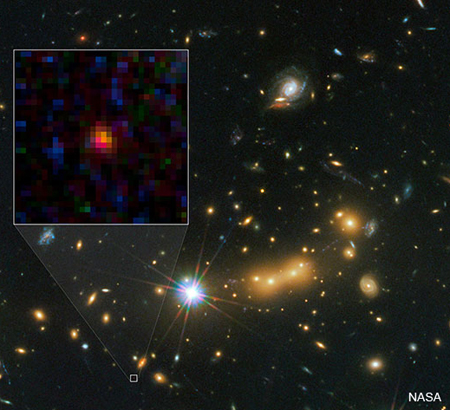
The farthest galaxy appears as a diminutive blob that is only a tiny fraction of the size of our Milky Way Galaxy. But it offers a peek back into a time when the universe was only 420 million years old after the Big Bang, The galaxy, named MACS0647-JD discovered in November, 2012, produced light that has traveled 13.3 billion years to reach the earth. MACS0647-JD has a redshift of 10.7, the highest galaxy redshift ever recorded and still visible (not a temporary flash). MACS0647-JD was discovered by using the gravitational lens technique described in the section above this one.
MACS0647-JD is so small it may be in the first phase of forming a larger galaxy. An analysis shows the galaxy is less than 600 light years wide. Based on observations of somewhat closer galaxies, astronomers estimate that a typical galaxy of a similar age should be at least 2,000 light years wide. For comparison, the Large Magellanic Cloud, a dwarf galaxy companion to the Milky Way, is 14,000 light years wide. Our Milky Way is about 100,000 light years across.
The new long distance champion is the second remote galaxy uncovered in the Cluster Lensing And Supernova Survey with Hubble (CLASH), a multi-wavelength census of 25 hefty galaxy clusters being studied with Hubble's Advanced Camera for Surveys (ACS) and the Wide Field Camera 3 (WFC3). Earlier, the CLASH team announced the discovery of a galaxy that existed when the universe was 490 million years old, 70 million years later than the new record breaking galaxy.
It should be noted that new distant galaxies are being discovered all the time. Also, the images are so dim and small that it is difficult to calculate the redshifts. As the techniques of discovery get refined, redshift estimates are often revised up or down. Some estimates have not been confirmed by independant parties. At times there are differences of opinion among cosmologists about which galaxies are the oldest and farthest. Net-net, exactly which galaxy is the most distant is a very fluid discussion and subject to change. Top
The Pinwheel Galaxy
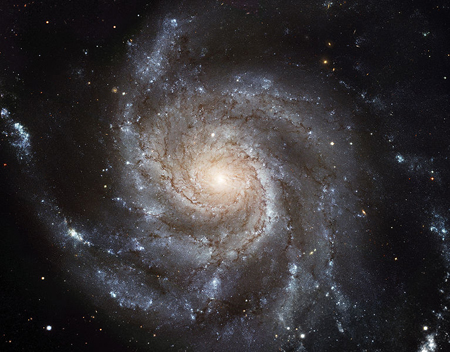
The Pinwheel Galaxy, also known as Messier 101, M101, and NGC 5457, is 21 million light years from earth. The portrait to the left is actually composed of 51 individual Hubble exposures. It is about 70% larger than our own Milky Way, with a diameter of about 170,000 light years. M101 is estimated to contain hundreds of billions of stars. In August, 2011, a Type Ia supernova, SN 2011fe, was discovered in M101. This was the fourth supernova recorded in M101.
Spiral galaxies, like M101, have well-defined spiral arms that wind around the galaxy within a rotating pancake-shaped disk. In this Hubble “face-on” view of M101, bright blue areas of star formation pepper the spiral arms, which look like the arms of a pinwheel. Dark, thin dust lanes follow the spiral structure into a yellowish central bulge containing older stars. Many of the stars are smaller, cooler, and redder than our Sun. The hot, blue stars along the spiral arms are so bright that they really stand out in this image.
M101’s disk is so thin that the Hubble telescope easily sees many more distant galaxies lying behind it. Seeing these background galaxies shows

that the galaxy’s disk is really mostly empty space.
The second image of the Pinwheel Galaxy to the left combines data in the visible, infrared, ultraviolet and x-ray spectra from four different NASA space telescopes. This multi-spectral view shows that both young and old stars are about evenly distributed along M101's tightly-wound spiral arms.
The red colors in the image show infrared light, as seen by the Spitzer Space Telescope. These areas show the heat emitted by dusty lanes in the galaxy arms where stars are forming.
The yellow component is visible light, observed by the Hubble Space Telescope. Most of this light comes from stars. They trace the same spiral structure as the dust lanes seen in the infrared.
The blue areas are ultraviolet light, given out by hot, young stars that formed about 1 million years ago. The Galaxy Evolution Explorer (GALEX) captured this component of the image.
The hottest areas are shown in purple, where the Chandra X-ray telescope observed X-ray emissions from exploded stars, million-degree gases, and ejections from a black hole accretion disk. Top
The Largest Known Galaxy

The largest known galaxy is NGC 6872, a spiral found 212 million light years away in the southern constellation Pavo. The distance between NGC 6872's two huge spiral arms, tip to tip, is 522,000 light years. This makes it 5 times larger than the Milky Way which is about 100,000 light years wide. NGC 6872 has ranked high among largest spiral galaxies for decades. However, it was only recently determined to be the largest after a detailed study by a number of instruments, including NASA's Galaxy Evolution Explorer spacecraft, GALEX.
NGC 6872's bar, which links the galaxy's arms and its central regions, is also huge. With a radius of 26,000 light years, it is about twice as big as the bars of nearby spirals. No evidence of recent star formation is apparent in NGC 6872's bar, suggesting that it formed several billion years ago or more. NCG 6872's enormous size and odd appearance are the consequence of its gravitational interaction with a neighbor galaxy called IC 4970, which contains just 20 percent of NGC 6872's mass. Computer simulations suggest that IC 4970 made its closest approach about 130 million years ago, stirring up a burst of activity in certain parts of NCG 6872.
The composite image above of NGC 6872 combines visible light images from the European Southern Observatory's Very Large Telescope with far-ultraviolet data from NASA's GALEX and infrared data acquired by NASA's Spitzer Space Telescope. Top
Andromeda And Milky Way Collision

The Andromeda Galaxy, also known as Messier 31, M31, or NGC 224, is a spiral galaxy approximately 2.5 million light years from earth. The Andromeda Galaxy is the nearest spiral galaxy to our Milky Way, but not the closest galaxy. (There are quite a few dwarf galaxies nearby.) It is the largest galaxy in the "Local Group" of 50 galaxies with about a trillion stars. The Milky Way is the second largest galaxy with roughly 300 billion stars.
Andromeda was born about 10 billion years ago from the merger of many smaller proto-galaxies, resulting in a galaxy smaller than the one we see today. Andromeda, as we see it today, was formed out of the collision of two smaller galaxies that took place 8 billion years ago. In the last two billion years Andromeda has absorbed some of its smaller satellite galaxies.
Andromeda has a "blue" shift (opposite of a red shift) of -.001. The minus sign means that Andromeda is coming towards the Milky Way at about 75 miles per second (270,000 mph). The two galaxies are expected to collide in about 4.5 billion years. A likely outcome of the collision is that the galaxies will merge to form a giant "elliptical" galaxy.
When two galaxies collide, simulations show the stars will pass right on by each other without colliding. The distances between stars is so large compared to the sizes of the stars that star to star collisions are very rare. While the distances between galaxies is large, compared to the size of the galaxies, the distances are not extreme. Stars, inside two galaxies that have merged, do not collide because the distances between them are hundreds of thousands to millions of times larger than the size of the stars. The distances between galaxies are only a few tens of times bigger than the individual galaxy sizes. Andromeda, our closest large galaxy, is only about 30 Milky Way diameters away.